DAYS 6-8 – Friday-Sunday August 18-20:
At the end of this long week, these three mystical days seemed to blend together into one.
On the spinal side of things, the mission team split up so some could stay for the surgery on I.K., a 64 years-young female patient who was postponed earlier in the week pending blood test results. Sometimes, a low Vitamin B12 level can cause the same neurological symptoms as an insult to the spinal cord. So, to justify a surgery, we had to rule out a B12 deficiency (pernicious anemia). Overnight Friday, her blood tests came back and showed her to have a normal B12 level, so Drs. Kris and Kirill reassessed the patient on Saturday morning and went ahead with the surgery at Case hospital. It was another straight forward spine procedure even with poor lighting and less than ideal instruments.
Early Friday morning, the second half of the team ventured upon the final leg of the torah mission to Putti, a small village near Mbale (“Em-ball-ay”). “Ohhhhhhh Lord,” we prayed, “please deliver us and the precious sefer Torah to the village of Putti.” Alex, Brian, Jordan, Judah, Doctor & Saftah Lieberman and the torah rode with Amos (our energetic driver), while Arne (the Dutch free lance reporter) and 150 Kinder Kits followed (almost too) closely behind. The apparently “220 km drive” took us Eastward along Lake Victoria for four hours on treacherously narrow, pitted roads and dusty boda-boda trails to the foot of Mount Elgon in the town of Mbale. When we finally reached Putti we were greeted by the village population, adults and children alike, charging the van with jubilant shrieking reminiscent of the peacock mating call. The torah as promised had arrived at its new home.
The Putti village was quite remarkable. There were a few small shacks for homes, and five larger structures. Of these buildings, is a kitchen with a sign post memorializing the “The Challah Project,” which had been donated to help the Abayudayah Jewish peoples prepare their Sabbath bread. Also donated was a solar-powered chicken coup. Veterans noted that there were no chickens around last year, as they had been exterminated due to illness. Now, chickens roamed the dusty field and a sad-looking dog named “Master” wandered existentially. The children were many. The older ones would smile, but the younger ones were instinctively wary of “Muzungos” (whites). Of the Abayudayah, there were 130 children and another 40 adults in Putti. Jordan contrasted the age distribution to similar-sized Jewish communities he had met in Bolivia, where the stats were perfectly reversed, with shrinking communities.
The history of the Putti Abayudayah started in the late 1800s. An elephant hunter named Semei Kakungulu began studying the bible. Upon further learning, he found his connection to the Old Testament, the books of Moses. He circumcised himself and his sons, a sign of Abraham’s (the first Jewish man) covenant with God. We don’t know how thrilled his middle-aged followers were about this initiation process at the time, but the incredible strength and devotion of the Abayudayah now speaks of their commitment to the Jewish faith. There are about a thousand Abayudayah in Uganda, but the orthodox ones (170) live in and around Putti. As they are not blood-descendants of Abraham, they have struggled for religious recognition for nearly one hundred years. The former dictator Idi Amin had banished them and the few who survived after the ban was lifted became the new generation of the Abayudayah. They prayed in a mud hut with a straw roof that was no larger than…well…a modest spine operating theater! A large Israeli flag covered half the back wall and Shabbat candles were stabilized with dried wax on the cement floor. Right next door stood the much larger new synagogue, which was about five times the size; aside from being large enough for all the Abayudayah, no wolf (or snake) could huff or puff or blow this brick synagaogue down.
The village’s old synagogue next to the new one, which is currently being constructed.
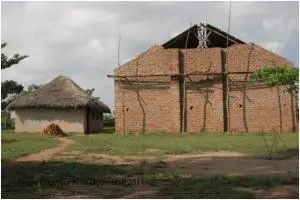
After unloading 15 boxes of Kinder Kits into the old synagogue, the villagers tied a sheet to four long sticks to build a “chuppah” (a Jewish ceremonial canopy used at weddings and Torah dedications).
Dr. Lieberman and the very proud “Chairman of the Board” with the newly presented Torah.
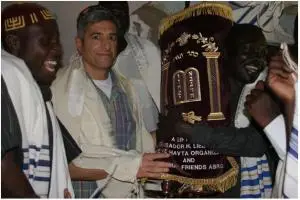
Torah in hand, Dr. Lieberman marched under the chuppah around the village, then to the old synagogue while the villagers rejoiced singing their favorite song, “We Love Torah.” It was then ceremonially placed in the Aron Hakodesh (holy arc) next to the original paper Torah replica that so compelled Dr. Lieberman to promise the delivery of the real one.
The joy of the Putti people was electric during the parade around the village with the Torah in hand.
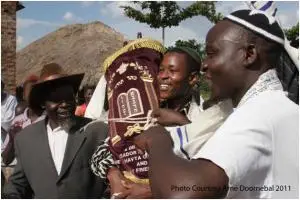
The entire community gathered in the synagogue for a special mid-afternoon service. Nobody could find the words to express their joy and gratitude, but that didn’t stop them from trying.
The congregation captivated by the inaugural reading of the sefer Torah.
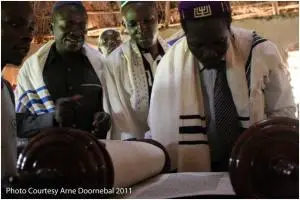
Dr. Lieberman spoke of the meaning of being Jewish, and Jordan spoke of Veahavta and the Kinder Kits. The kids then swarmed Jordan like the killer bees buzzing about in the papyrus thatched roof just above us and each got a backpack which they wore proudly. Brian taught the kids how to load lead pencils and how to spin a dreidel (special Hanuka toy) in the palms of their hands.
Joy and passion exuded from all present on this glorious day.
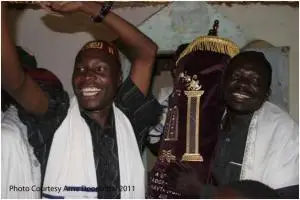
The new Torah next to the paper scroll.
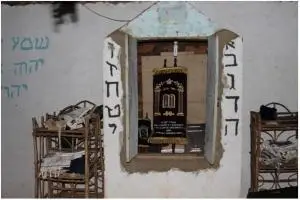
The Torah delivery delegation with the recipient rabbi.
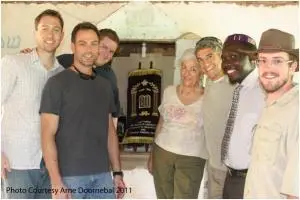
The most excited girl of the day runs through the village with what may be her second bag.

All the kids in Putti with their new Kinder Kits. Red looks good on the village.
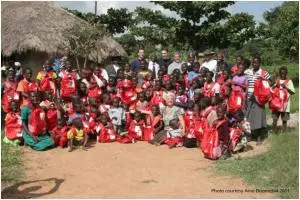
The next 24 hours passed like a dream. In Putti, the Sabbath started when we saw 3 stars in the night skies. No clocks, no watches, and no calendars to adhere by. Every day consistently has 12 hours of sunlight because they are so close to the equator: no real seasons either – just a couple rainy ones. We attended services on Friday evening and after services we broke bread with the villagers and ate the sweetest challah that we’d ever salted. We were invited to stay for dinner and we simply could not refuse! With no utensils, and the evening darkness over us, Arnie, Jordan and Brian graciously shared a plate while Dr. Lieberman and the Rabbi did the same.
How do you share a meal in Putti? Why, by eating off of one plate, in the dark, with your hands, of course!

On Saturday, Alex our hard-working IT man took charge. He followed along in English intrigued by a prayer service quite foreign to him. Even Amos piped up and asked about the meaning of Torah, Tallit and Tefillin.
Alex taught the kids hopscotch, Simon Says and duck-duck goose much to their delight. Brian stirred flour, toured the agricultural grounds. Jordan chatted with the cantor, Moshe, discussing the Abayudayah’s love of music. After Shabbat they traded CD’s of their respective choirs – “When I Wake Up – the Music of Putti” for “This One’s a Kippah,” of the University of Toronto Varsity Jews A Cappella group. Judah meanwhile played volleyball and football (“soccer”) with the teens and tods, respectively, with imaginary nets. For the record Judah, who some called Jonah, is a unique individual. An accomplished outdoorsman with a BS of Electrical Engineering and a Masters in Geologic Sciences, Judah played an integral role in the torah project. In addition to being the “mule” (bringing the Torah in its massive indestructible, everything proof, floatable case, on the connecting flight to Uganda), he built the website, helped raise money for the purchase of the torah, and worked closely with Doctors Lieberman and Rabbis Bloomenstiel and Zakon. As if that was not enough, Judah is staying in Putti for three weeks to install an irrigation system to water their crops, and teach them to raise chickens. How does Judah know how to raise a chicken farm, you ask? One of the 8 books he brought with him to Putti was “Chicken Farming for Dummies.” He will learn, he will teach, and he will hopefully come back alive, lest a cobra leaps into his jungle hammock.
Energized by a restful Sabbath, the team departed Putti (minus Judah) and stopped at the Nile’s Bujagali Falls near Jinja, on the road back to Kampala. The Nile begins at nearby Lake Victoria and flows into the Mediterranean Sea at Alexandria in Egypt. Amos, not content with just driving us on the life threatening roads in Uganda, even offered to captain a raft for us on the Nile. At the falls we watched as risky local teens come bobbing down the rapids for money. Every year two or three teenage daredevils die in the Bujagali falls in their quest for a livelihood which pays them 3000 Ugandan shilling (the equivalent of $1) per trip down the rapids. Once we finally returned back to Kampala the team united again, we went for a late night dinner across the road from the apartment at “The Pyramids” Hotel and Casino. Dr. Sieminow chose the very adventurous “deep fried chicken,” while Alex, Jordan and Dr. Lieberman compared surgical skills as they dissected their whole Tilapia caught fresh from the lake. After that display of skills, Jordan was banned from the O.R.
These were days of miracle and mysticism. From the Israeli flag in the man’s back mirror to the plastic Jewish star on our doorstep days prior, signs of the torah mission were pointing to success. But it didn’t end there. Our motel in Mbale gave us room number 18, which in Judaism symbolizes life, just before the torah arrived in Putti on Friday. Soon after the torah presentation, we witnessed a rainbow in the field that the Rabbi pointed out then followed with the prayer memorializing the covenant between God and Noah. The story of Noah’s ark in the Old Testament tells us about the significance of the rainbow; it is a gift given from God to man to remind us of the sacred covenant: the covenant that he would never flood the earth with rains again. Only, it had not even rained in Putti. It was a very special moment for all of us, bringing full circle the promise of delivering a Torah to Putti.
And even more symbolic, after dinner we decided to assess the Ugandan definition of “casino” with a quick walk-through. While passing the roulette table, the empty-pocketed Jordan joked to Failla: “Let’s put 10,000 Shillings on number 18 for Putti.” The ball was thrown and sure enough, it landed on number 18. Despite the “could have, would have, should have” bantering, the whole sequence of events verified the importance of the weekend to the village of Putti and to all of us.
On Sunday the team visited the Equator and nearby craft shops, sharing the events of days past and those to come. Disappointed by the closing of the famous French-Fries shop, talked up endlessly by the veterans, we ordered Nile specials and greasy fries at the next local restaurant and once filled moved on to visit the local neighborhood crocodile farm. There the 68 year-old monster croc Cleopatra recognized Dr. Lieberman and Failla, boasting its ancient teeth in their presence. Returning back to Kampala that evening was the most harrowing experience of most of the team member’s lives. We were inescapably involved it the worst traffic jam of our lives. Truly bumper-to-bumper, mirror-to-mirror, with boda-bodas crammed to fill the space in between. Veterans noted that it had never been this bad in previous years, and that the recent increase in car-shipping to Uganda has caused dramatic changes in street congestion in the city. We are convinced that Uganda has the best and worst drivers in the world. On arrival to Kampala we returned to Mamba point for avocado pizzas, said our goodbyes to Dr. Kris Semienow, who by the way just ordered a sealed bottle of water for dinner, in fear of the potential gastro-intestinal consequences of anything else, while on an airline flight.
Quotes of the Day(s):
“Dorit, you’re not in Kampala anymore!”
“His name’s not Jonah, it’s JUDAH! Jonah got swallowed by the whale…Judah got swallowed by the village of Putti!”
“Being Jewish isn’t about where you were born, the colour of your skin, or what your name is. It’s about what you feel: what’s in your heart.”


